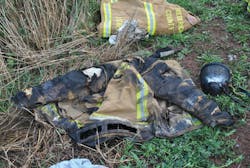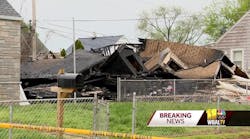We all have been dispatched to runs that sound routine and to others where the dispatcher's voice makes it clear that this run will be serious. The difference should be minimal. While in many cases the dispatchers do know what is going on, sometimes they don't know or the information is not relayed properly. Either way, we have to be prepared and be ready to function as if there is a fire, with the worst-case scenario, until we get there and determine what it is, or what it is not.
"Being ready" takes on several levels of importance. Being ready means:
• Pre-planning. This mean knowing the area and the structures well before the run comes in. Pre-planning should be done by "community" or "subdivision," and not just large-area commercial or other non-single-family structures.
• Pre-determined staffing. It's 2010 and be it an all-volunteer fire department, a combination fire department or a career fire department, we should know right now how many members will be available to turn out. There are so many simple ways that, for example, a volunteer fire department can determine who is around, who is available and who is responding. There are many inexpensive systems (such as www.IamResponding.com) that allow the fire department to know immediately who is responding, as opposed to waiting to see who shows up. Knowing "who is responding" is also of value to career fire departments that rely on call-backs for runs.
• Alarm assignments. Does your fire department send the same response no matter what kind of building is reported to be on fire? Why? Does that really make sense? Should a 10,000-square-foot house in a non-hydranted area get the same response as a hydranted 900-square-foot dwelling? Should an occupied school get the same response as the house fire?
We need to plan before the run comes in so that we are able to match our response to the incident potential. And that takes on a personal aspect as well. As firefighters, we personally must be prepared and that starts at probie school and continues on for our entire career, every day, on every run and with every day being a training day.
In this month's part one, we will take a close look at the area of firefighter preparedness and how seemingly simple things can make a huge, huge difference. We are going to look at how the simple issue of properly wearing bunker gear can make a major difference in our ability to survive or not.
As a firefighter, recognize that your fire department must be "organizationally" ready and the responsibility falls from the commissioner to the chief to the officers to the firefighters and to the newest probie. However, as a firefighter, you also have a personal responsibility to do your share — from personally taking responsibility for your actions to doing some training on your own by reading, studying, and taking the initiative to go through the compartments and knowing all the tools as an expert would (expert = firefighter) as well as something as seemingly simple as knowing to wear (and how to wear) your bunker gear.
Not much comes between you and the fire but your bunker gear! Knowing how to use and wear bunker gear perfectly by all firefighters should not be taken for granted by any chief. Ensuring that your members understand every aspect of their gear, what it is capable of and what it is not capable of, is critical. Part of that is the cleaning and care of the gear.
Years ago, the dirtier the gear, the "cooler" it was, but today we understand that the "dirt" on that gear contains carcinogens. We want to minimize any contact with these cancer-causing agents.
Note: National Fire Protection Association (NFPA) 1851, Standard on Selection, Care and Maintenance of Protective Ensembles for Structural Firefighting and Proximity Firefighting, was developed to reduce the safety risks and potential health hazards related to turnout/bunker gear care, maintenance and repair. The intent of the standard is to protect firefighters, their families and the general public — essentially, anyone they might come in contact with because they all have the potential to become contaminated. NFPA 1851 defines the guidelines concerning standard operating procedures (SOPs) and roles and responsibilities of record keeping, inspection, cleaning, decontamination and repair of your gear. You can get a complete copy of NFPA 1851 at www.nfpa.org or through your bunker gear supplier.
Critically important is every firefighter knowing that full protective gear (helmet with chin strap worn, hood in position, gloves worn, coat fully closed with neck/collar protection up, pants fully closed and boots on) must be worn properly on every run and can go a long way in helping the public and helping ourselves.
Each one of us at one time or another forgot to wear a hood, didn't want to use the self-contained breathing apparatus (SCBA) in the false belief that "a little smoke won't hurt," or simply slacked off due to laziness or getting too comfortable. And that's when we can get in trouble. Sure, the weather may be hot or we don't want to pack up because it doesn't look too bad, but that's what gets us in trouble. It's similar to a football player putting his helmet on "only when he needs it," which is pretty stupid logic. But it is significantly more stupid for us go into any incident without being fully prepared for the worst.
In this month's case study, fortunately, these firefighters from Frederick County, MD, understood the importance of being fully prepared, personally prepared, just in case something goes wrong. And it did. So often, it's a combination of small "things forgotten or ignored" at a fire that can lead to tragic outcomes. In this month's close call, we see how firefighters properly understand the importance of being fully prepared.
Our sincere thanks to the officers and members of the New Midway Volunteer Fire Department Company 9 and Union Bridge Volunteer Fire Department Company 8, as well as the officers and members of the Frederick County Department of Fire & Rescue Services, Director Thomas Owens and Safety Chief Michael Crawford for their assistance with this close call account.
Fire and rescue services in Frederick County are provided by 26 fire, rescue or EMS community-based volunteer organizations supported by the Frederick County Division of Fire and Rescue Service. That division has more than 300 uniformed and civilian personnel providing response, dispatch, training and fire marshals/prevention services.
The following account was provided by Firefighter Jed Gregory:
On the way to the fire, we received reports of three children trapped in the structure. When Engine 81 arrived on scene, Firefighter Cody Isanogle and I defeated the lock to the gate and proceeded up the hill to the house. Once at the house, we could see that it was the trailer behind the house actually on fire. Bystanders told us that the children were in the trailer. Firefighter Isanogle and I evaluated the structure from side A, then side B, then side C as we walked around the structure. We noted fire through the roof in the center of the structure from side C, visible from side A as well. The room on the B/C corner of the trailer had both windows open with light smoke coming out. The door to side C was open already and there was heavy fire to the left of the door.
The room on the B/C corner still appeared viable, so Firefighter Isanogle alerted Chief 9 that we wanted to enter side C and search that room quickly and then come back out based on the reports of children trapped. Chief 9 replied with "do a quick search" and we proceeded into the side-C door properly dressed in full turnout gear and breathing apparatus. I led into the structure and immediately turned right for a right-hand search, which would lead us directly into the room on the B/C corner.
Approximately six to seven steps into the structure, the heat became intense and within seconds the room that was previously showing only light smoke was fully involved in flames. I felt my hands burning, yelled to Firefighter Isanogle, and we proceeded to exit the structure. Firefighter Isanogle grabbed my shoulder as I took a step too far past the side C door that we had entered and then I walked out of the door unassisted.
Once outside, I shook my hands until my gloves went flying. I couldn't see because my facepiece was black, but I could hear voices. I began walking toward where I thought Engine 81 had finally parked so that someone could strip me out of my gear. I stopped when I walked into a tree just outside of the gate to the fenced yard. Chief 8–1 and Firefighter Isanogle removed my helmet, breathing apparatus, hood, facepiece and turnout coat. I removed my turnout pants and boots and then walked down to an EMS unit. I was transported to Frederick Memorial Hospital and treated for first- and second-degree burns to both hands, forearms, left elbow and right shoulder.
WILLIAM GOLDFEDER, EFO, a Firehouse® contributing editor, is a 33-year veteran of the fire service. He is a deputy chief with the Loveland-Symmes Fire Department in Ohio, an ISO Class 2 and CAAS-accredited department. Goldfeder has been a chief officer since 1982, has served on numerous IAFC and NFPA committees, and is a past commissioner with the Commission on Fire Accreditation International. He is a graduate of the Executive Fire Officer Program at the National Fire Academy and is an active writer, speaker and instructor on fire service operational issues. Goldfeder and Gordon Graham host the free and noncommercial firefighter safety and survival website www.FirefighterCloseCalls.com. Goldfeder may be contacted at [email protected].






